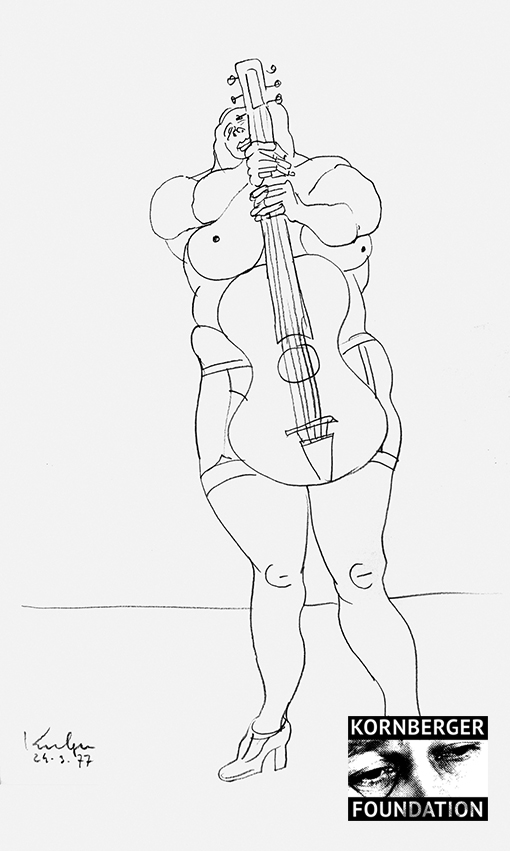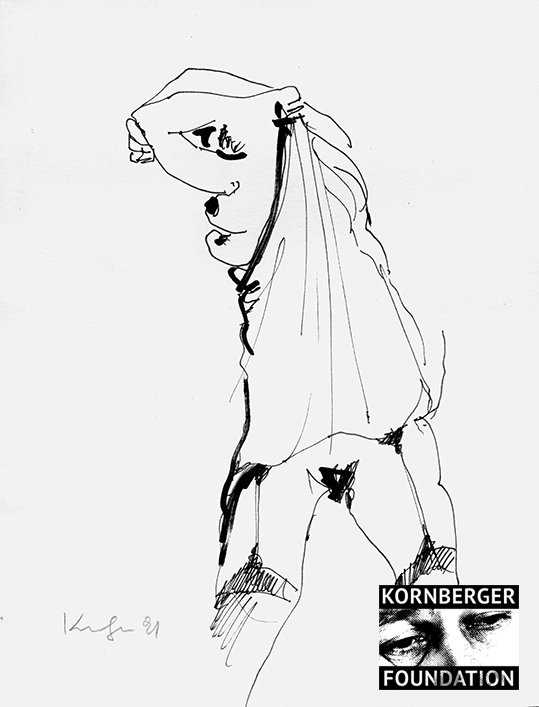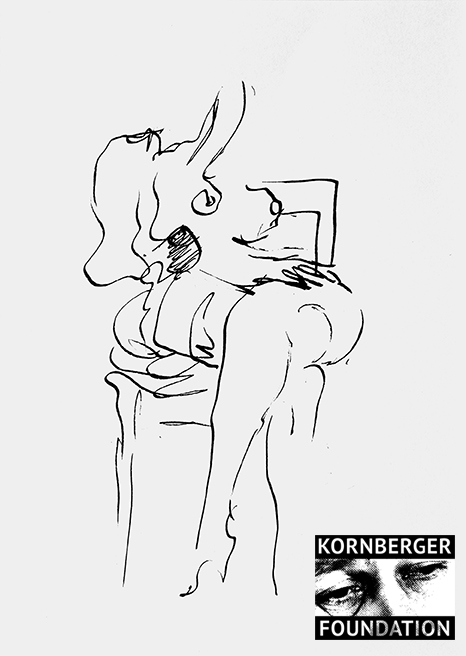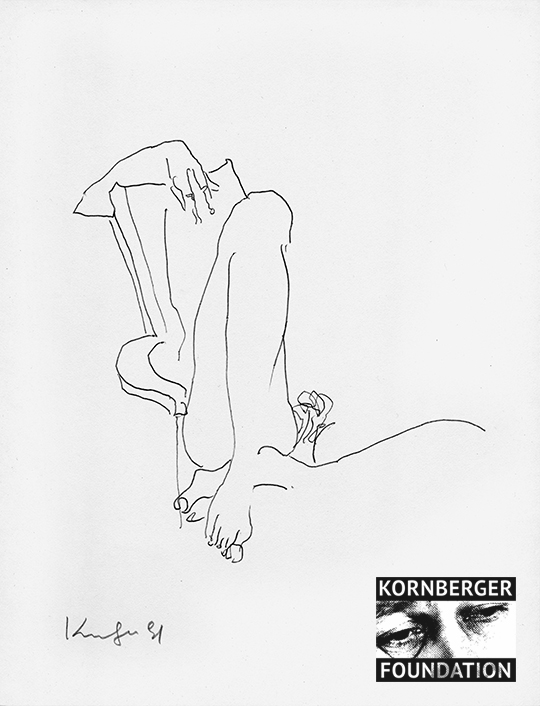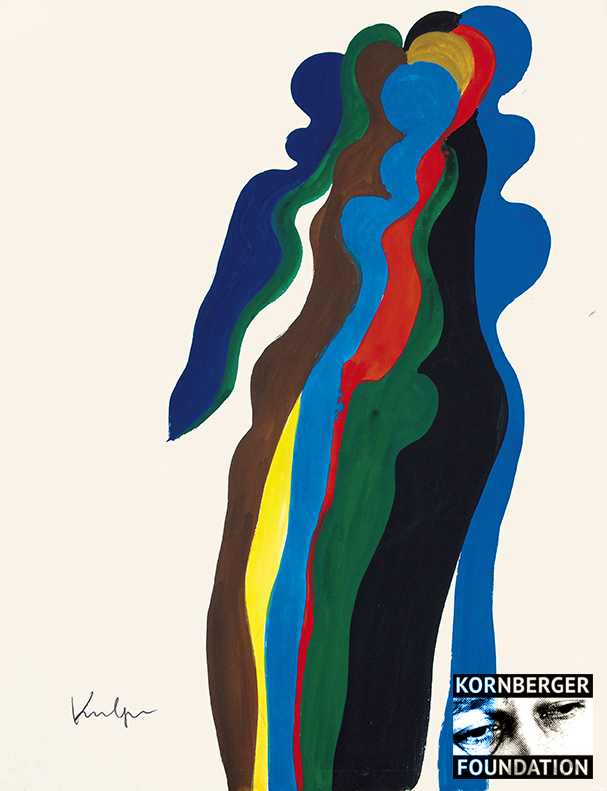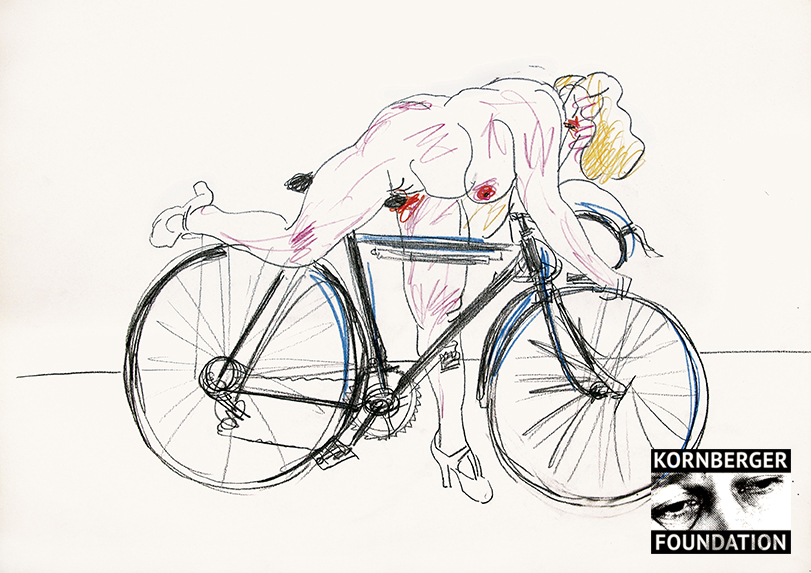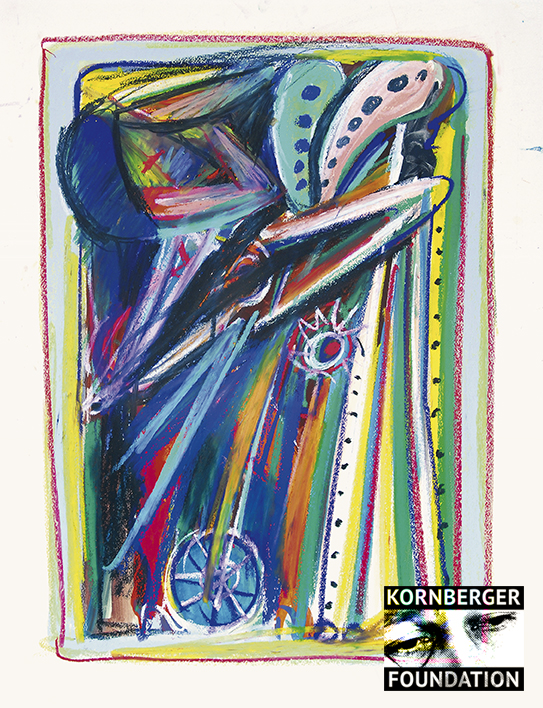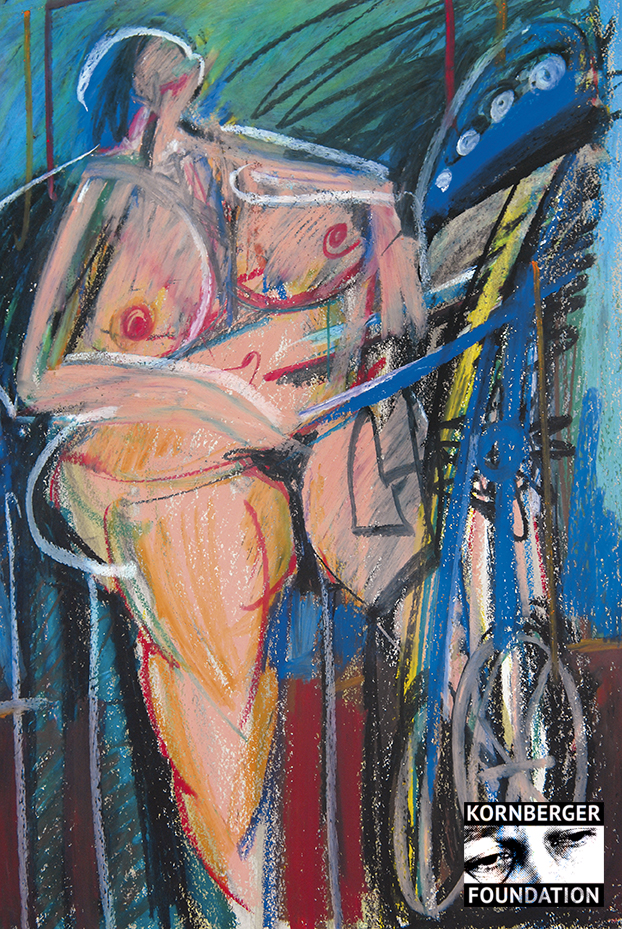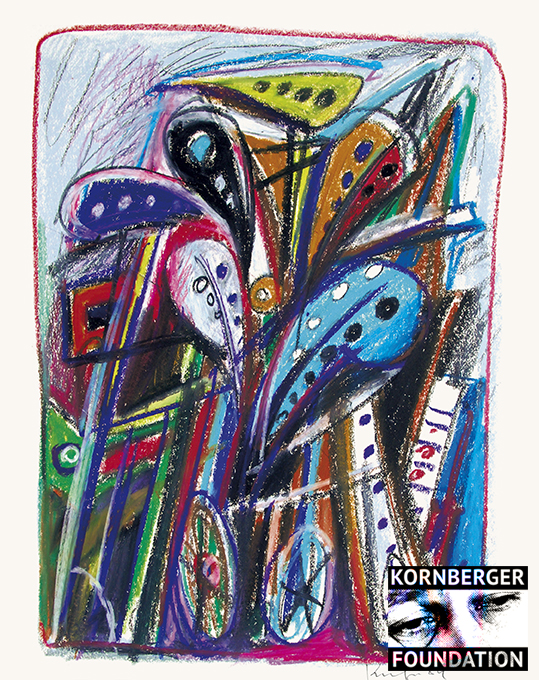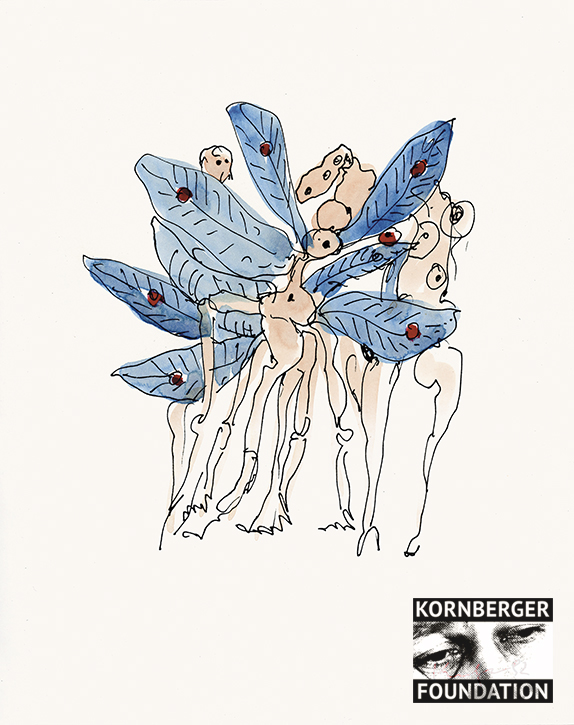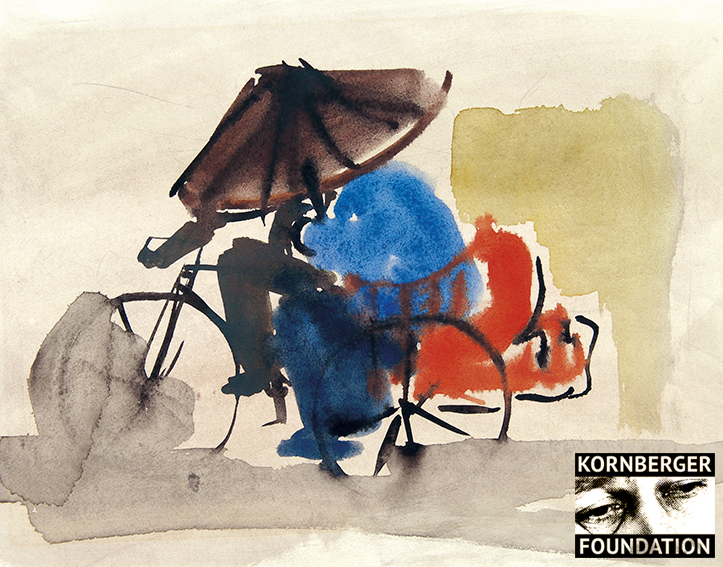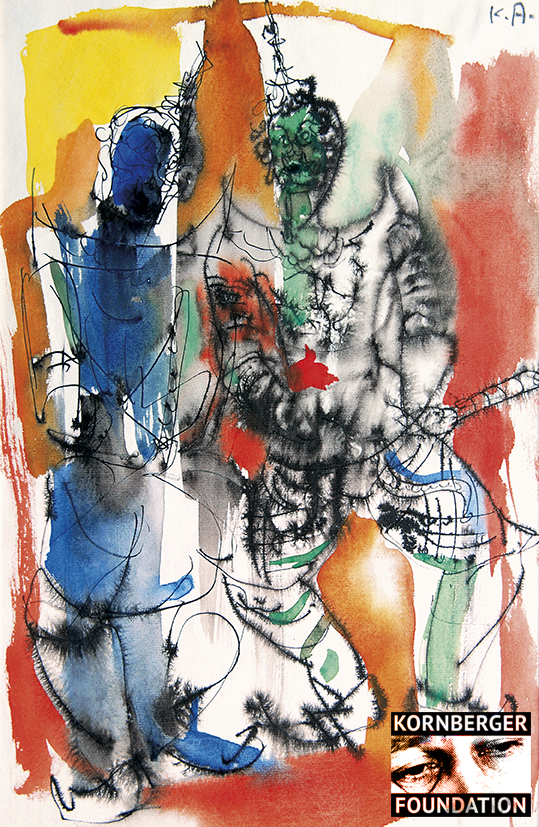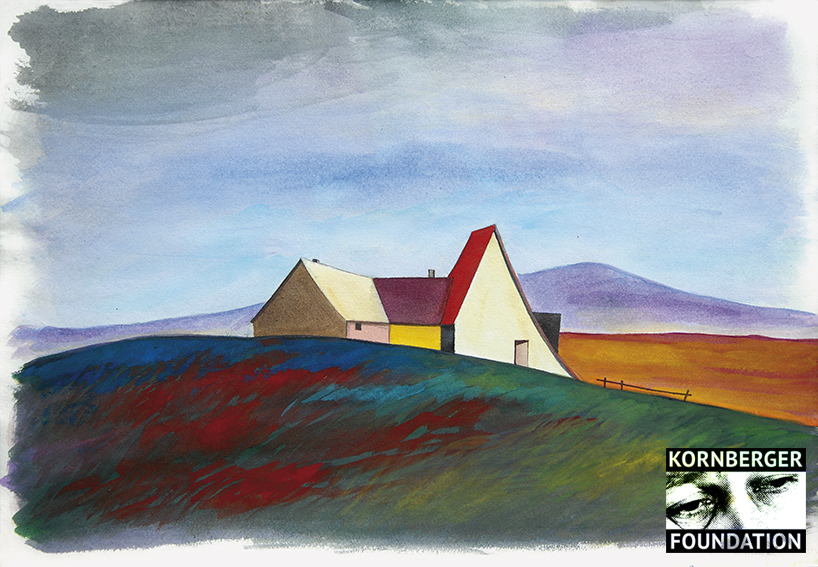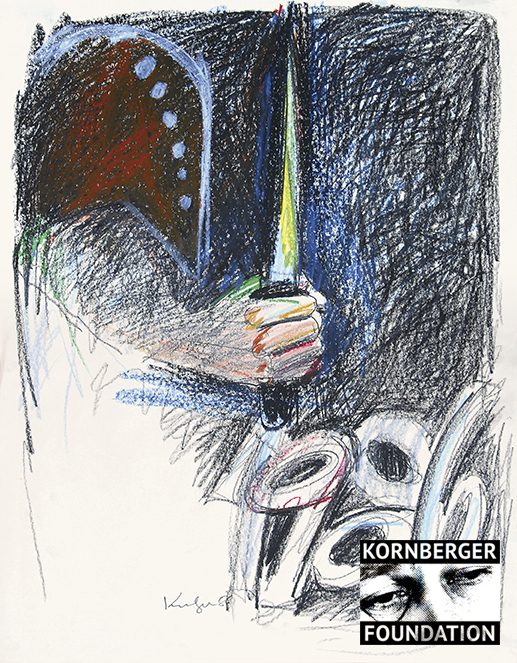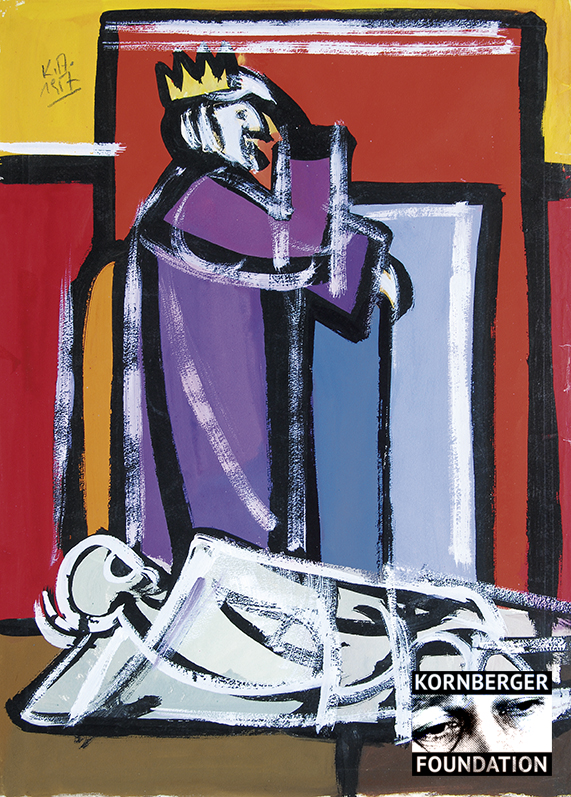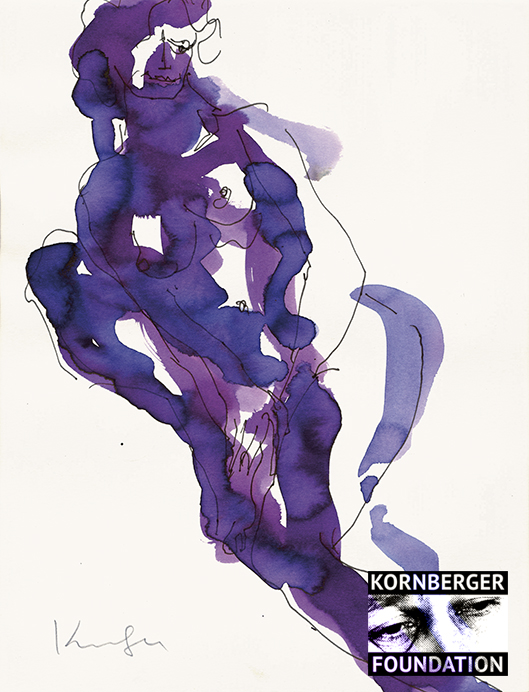Alfred Kornberger and his artistic Œuvre
There is no doubt, Alfred Kornberger is one of the great colorists in the painting of the 20th Century. Color is the most important statement in his images. This relates to the psychological component as well as their symbolic statement. The real artist knows to change colors into sounds. „Depending on the temperament and intuition the colour will be delicate or strong, broken or pure - or colorful, cool, or warm. In any case, the color will reach what the painter asked of it and needs, to achieve the spiritualization in his work“, explains the artist.
Alfred Kornberger was born on the 3rd of July 1933 in the suburban of Vienna in a working class environment.
From the beginning, Kornbergers art belongs to the Austrian tradition of depicting the human body that spans from Egon Schiele to Alfred Hrdlicka.
From about 1970 onwards, Kornberger turned his attention completely towards the female nude. In his studio in the Viennese district of Währing nude models were constantly working for the painter, but also for many of his students. The focal point of Kornberger's life was his spacious studio that can be compared somewhat to what the studio meant for British painter Francis Bacon. Kornberger's studio was a place of convivial artist festivals where, besides painter-colleagues, regularly writers and musicians got together as well.
The strict professor promotes his talented pupil
In 1952 Kornberger was admitted to the Academy of Fine Arts in Vienna in the master class of Robin Christian Andersen. Andersen had been a professor in the Vienna Academy since 1945. He was among the early combatants of the heroic years of Expressionism before World War II. He belonged to the circle of »Neukunstgruppe (New Art Group)« form around Egon Schiele, and was a member of the »Kunstschau (art exhibit)« which had developed out of the Klimt group and in the 1930s was considered as one of the leading members of the Secessionist movement who were represented regularly at the exhibitions of the Vienna Secession. As early as the 1920s Andersen directed a private art school in which he fostered a very rigid teaching based strictly on didactic principles.
Even after his appointment as professor at the Vienna Academy, he worshiped a very dogmatic teaching principle, that was based on objective representation and a rigidly geometric form analysis. Under the title of »Anderson School«, the master class soon became synonymous with a somewhat dry, but solid, rationally-oriented teaching method. Early Andersen students who graduated from the Academy in the late 1940s included, among others, Giselbert Hoke and Friedensreich Hundertwasser. Alfred Kornbergers talent was evident and supported by Andersen, Hundertwasser abandoned the Academy soon after a few weeks.
Stylistic orientation
For the stylistic orientation in his younger time, Alfred Kornberger looked to the École de Paris, particularly to the art of Braque and Picasso. Kornberger's early pictures are intensive efforts of coming to terms with Cubism and Surrealism. The artist was also preoccupied with subjects connected with technical progress, for example in his cycle depicting machines.
From the late 1960s, Alfred Kornberger turned to the topic of the femal nude, which him never would let go. Parallels to his nude studies are to be found in the work of the group called the Naturalists, who in the 1960s and 1970s kept up the tradition of objective figural painting. The group included the sculptor Alfred Hrdlicka, as well as the painters Fritz Martinz and Hans Eisler. In a wider sense, Adolf Frohner may also be counted as one of members of this circle. Both the impressive studio pictures by Eisler, as well as Frohner's aesthetics of fragmented female torsi are reflected in the work of Kornberger.
The complete work includes seven main topics with a lot of cycles
Kornberger's late works, dating from the 1990s, advance towards a distinctly painterly, four-colour design, combining not only elements from Expressionism, but also the influence of the so called Fauves (French for »wild beasts«). Kornberger can definitely be considered as one of the great colourists of the late 20th century. Colour plays a central role in his work as an emotional factor of expression.
As with hardly any other of his contemporaries, the mature work of Alfred Kornberger is dominated by the motif of the female body. His almost obsessive preoccupation with the female nude reminds one of the great Austrian painter and graphic artist Egon Schiele. Like Schiele, Kornberger varied his view of the female nude from the male perspective. The eroticism of desire constantly plays a central role, as does the gaze of the voyeur. Kornberger presents his models both, in ecstatic contortions and in stylish elegance.
Despite the dominance of female nudes, Kornberger's paintings include also many other topics. In essence, his work can be divided into seven main topics: 1) the classical femal nude, 2) the Zeus-Cycle, 3) Insects and metamorphoses, 4) Representational with objects such as keys, nails or huts as well as still-life such as floral arrangements, water jugs or studio secessions, 5) the slaughterhouse-cycle, 6) gestic figures and portraits and at least 7) the abstracted femal nudes.
According to a exact timeline, this main topics belongs also to the following cycles: from 1961 start of the cycles „Apocalypse of Johannes“ and „Legend of Death“; from 1965 start of the cycle „Machine Images“; from 1970 turning on to the motif of the femal nude with cycles like „Nudes in the Gym-Hall“ and „Nudes at the Beach and Bath-rooms“; from 1975 start of the cycle „Waldviertel Landscapes“; from 1977 start of the cycles „Zeus and the Women“, „Moulin Rouge“ and „Power“; from 1985 start of the cycle „Representational“ and „Still-Lifes“; from 1987 start of the cycle „Insects and Metamorphoses“, „Ape and Woman“ and „Neid and Hate“ (from the „Johannes Apokalypse“) and from 1995 start of the cycles „Mentaly ill figures“ and „Slaughterhouse“.
The classical female Nudes
Only a few contemporary artists have operated in such complex and expressive colors and dynamic gestures such as Alfred Kornberger. This applies especially to his female nudes. In some published texts, Kornberger elaborates on the principles of his work:
„The artist transmits his ideas, his thoughts into the experience: that means, the experience gives him cause for his arrangement. And the visualization of the idea into the experience is the picturesque act. The significance of this lies in the communication to the recipient. The painter shows his environment individual but true facts. He uncovers hidden relationships and therefore he gives the subject an apparently new structure. Exactly these hidden relationships and facts are the ones who are pushing the discerning artists in his work. The painter creates a new order in his paintings. This order is necessary and so each part, each color, line and shape of the image is given the importance it deserves."
Kornberger speaks of the new order, which creates an artist in his works. The paintings of his nude motifs illustrate impressively this new view of things. He creates his own ideas about the anatomy of the female body where breasts appear not horizontally but vertically, where heads and arms disappear and bodies are bathed in dazzling color-kaleidoscopes. These daring paintings, against all conventions, corresponds to Kornberger "visualization" from idea into real experience.
The Zeus-Topic
From the year 1977, Alfred Kornberger begins to work with the motif of the bike. He gives the bike the name of the ancient god Zeus. Kornbergers Zeus is making love with the woman in the shape of the bike. Zeus, the supreme ruler of the gods with his penchant for love adventures masculinized himself in the shape of a bicycle, always abstracted rode, a machine. Zeus, the masculine, the transumter, a constructor and the constructed at the same time. Even in the works of the artist, Zeus transmutes himself, only the saddle recalls to the bike and out of this a head is formed and a bike boom which serves as the body.
Kornbergers Zeus are like machines, they remind to pictures of the Surrealists and alone until 1984 Kornberger created hundred works on this subject using various techniques. These anthropomorphic figures are very confusing, in the particular representations of human love couples the saddle-head becomes the symbol of a sensual lust operation which the human can impose themselves and live.
Insects and Metamorphosis
Insects and spiders exerted a great fascination to Alfred Kornberger. He was owner of a large tarantula, which he held in his studio in a terrarium. The many-limbed, fine legs of insects, the fragility of their appearance, the elegance of the movements, Kornberger admired all that greatly. Insects also inspired the artist to grotesque inventions of mythical creatures. Kornbergers sometimes macabre depictions of those hermaphrodites from human and insect built at the appearance a strong contrast to his other works, especially the intensely colored, voluptuous nudes.
After a closer study most of the works show a deliberate metamorphosis between human and animal or insect and woman. Often the insects have female breasts and a human-like head or in place of the head sits a large pair of eyes which could be also a female breast. The thinner legs are formed to stout thighs at the beginning of the body and so they remind again to nude motifs. Kornberger reinforces this impression by using asymmetrical scale and signal-like colours for his figures. Rarely an artist has invented bizarre and surrealere objects such as these insect-like hermaphrodites.
Representational
Equally in opposition to the ubiquitous representations of female nudes, Kornberger again and again adapts themes and motifs which are completely exceptional, not only for his work but also in the art of his time. This includes also representational motifs. One of the charms of these motifs is the reversal of the proportions. The large and sometimes gigantic representations obtain a meaning that hardly anyone would recognize in these banal objects.
Every detail obtained by such a representation gets a new importance and gives rise to further speculation. Only a little value Kornberger measures to the contrast and the spatial arrangement of the objects. It is irrelevant for the painter if the individual objects are arranged one behind the other or side by side. This is often not visible to the viewer.
Sometimes Kornberger is using a completely insulated alignment of the individual objects so that they appear as if only cut and pasted. The objects are lined up side by side or one above the other and are distinguished by bold colors. Faced like a shop window these objects often lose their original purpose and form a new, decorative ambiance.
Slaughterhouse
Mitte der 1990er-Jahre beschäftigt sich Alfred Kornberger mit dem Thema des Schlachthauses. Der Künstler sieht
Mid of the 1990s, Alfred Kornberger works with the subject of the slaughterhouse. The artist apparently sees a direct link between the raw, for human consumption intended meat and the plump flesh of his nude models. This reasoning also used famous fellow painter like the French Chaim Soutine or the English Francis Bacon in their artistic work. Kornberger means the injured Act, his intention is not to show the bleeding, suffering flesh.
In spite of great formal alienation and distortion of the person, the artist never wants to act rudely or brutally. He wants to give a minimum of painterly aesthetic that also reflects the attractiveness of the female body indirectly. The background is often designed as a wall tile and appears as a bathroom.
Kornberg uses the highly original uniform grid of square tiles for exciting and thrilling compositions. He creates coordinates for the organization of the composition and this grid system generates an abstract structure. The figures obtained an optical base from which they rise to vertical or the picturesque designed individual objects which are decomposed into individual plastic-looking forms and so they are perceived as non-representational color areas or gestural lines.
Gesture Portraits and Figures
Beside of his sprawling lifestyle Kornberger employs also with the darker side of life and the transience of human life. This works are determined by alternating states of mind in which the artist represents longer existing unrest and anxiety in his works. Besides his impressively gestural portraits and figures, this also includes the representation of horror. The in the mid 1990s resulting representations of screaming and mad men with distorting faces into a fearsome grimace belongs to that topic.
With that works he produced again his own artistic language. In these representations the body is not experienced as a dynamic, convulsive object, it appears as a static, shadow figure. These figures do not appear as vibrant individuals, they appear like visions out of the mind from the artist. In these late years, there are only a few images that represent the artist himself. Frequently are encrypted self-portraits of Kornberger and these images could be an autobiographical message that the artist wanted to capture here, like a dark image of his soul.
During these years a disease tied Kornberger to the bedside and these agonies were always accompanied by visions of death. Kornberger wrote to this in 1997: „The death is the crown of life. It is not appropriate to smile or fear about death. The death is the most essential part of the creation, the only way to develop new life and for preparing to the wedding with him.“
The abstracted female Nudes
In later years, Kornberger answered to the question of whether he could also paint differently than female acts: Of course it is possible to act without painting nudes. But for me it is the exploration of the female body at the moment of painting, the erotic moment that carries over to the pen, the mapping of an erotic landscape.“ „Erotic landscape“ ist the best description for his increasingly abstracted nudes.
The imagination of the artist isolated the erotic parts of the woman and transforms them into fetishes. Similarly Kornberger tells in his pictures about his erotic imagination in mind: the reduction of nude models on large round breasts and opulent thighs. The fragmented body parts often seem like islands emerging from the sea. The plastic, relief-like effect of this individual body parts emphasize the aspect of land formations. A sharp side light divides the colors in bright or dark areas and produces a surface relief.
The shapes of the act seams to disintegrate into bizarre items, they are described only as colored outlines. Their amorphous, curvy outlines often appear as a reflection or visual distortion. Whether these representations are the result of optical experiments or a visionary out of a mental reflection, the artist understood to paint things as they are directly traceable to the viewer. Kornberger considered painting as the unity of form and color which affect intellectually and emotionally.
Franz Smola „The nude as Innovation“ ; (Brandstätter Publishing house; Vienna, 2007)






